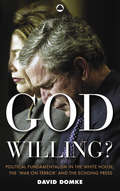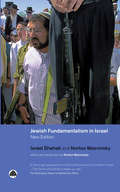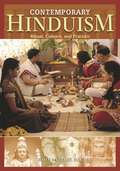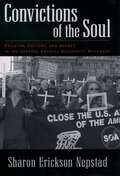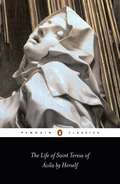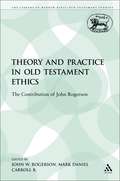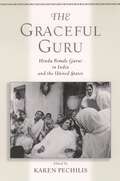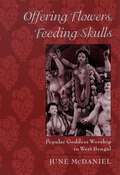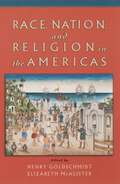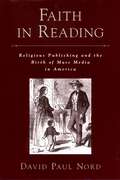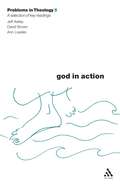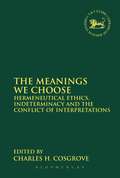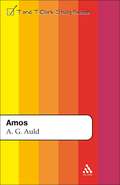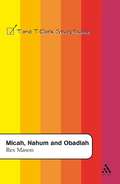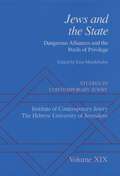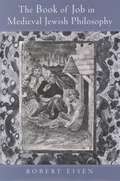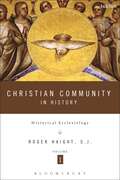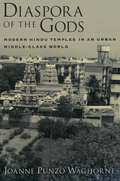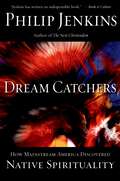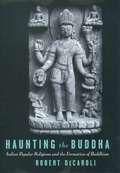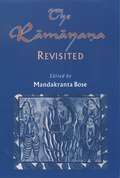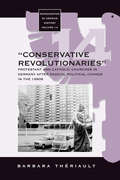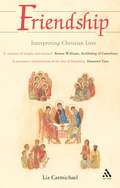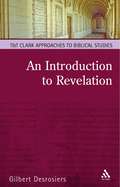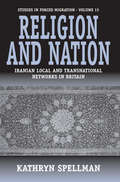- Table View
- List View
God Willing?: Political Fundamentalism in the White House, the 'War on Terror' and the Echoing Press
by David DomkeThe political fundamentalism, offered up by the Bush administration after 9/11, capitalised upon the fear felt by many Americans. In essence, it is a conservative-religious ideology, but via strategic communication choices, it was transformed into a policy agenda that feels political rather than religious. These communications dominated public discourse and public opinion for months on end and came at a significant cost for democracy.*BR**BR*The administration had help spreading its messages. The mainstream press consistently echoed the administration's communications - thereby disseminating, reinforcing and embedding the administration's fundamentalist worldview and helping to keep at bay Congress and any substantive public questioning. *BR**BR*This book analyzes hundreds of administration communications and news stories from September 2001 to Iraq in spring 2003 to examine how this occurred and what it means for U.S. politics and the global landscape.
Jewish Fundamentalism in Israel: New Introduction By Norton Mezvinsky
by Israel ShahakThis is a new edition of a classic and highly controversial book that examines the history and consequences of Jewish Fundamentalism in Israel. It is essential reading for anyone who wants a full understanding of the way religious extremism has affected the political development of the modern Israeli state.*BR**BR*Acclaimed writer and human rights campaigner Israel Shahak was, up until his death in 2001, one of the most respected of Israel's peace activists – he was, in the words of Gore Vidal, 'the latest - if not the last - of the great prophets.' Written by Shahak together with American scholar Norton Mezvinsky, this books shows how Jewish fundamentalism in Israel, as shown in the activities of religious settlers, is of great political importance.*BR**BR*The authors trace the history and development of Jewish fundamentalism. They place the assassination of Prime Minister Rabin in the context of what they see as a tradition of punishments and killings of those Jews perceived to be heretics. They conclude that Jewish fundamentalism is essentially hostile to democracy.
Contemporary Hinduism: Ritual, Culture, and Practice
by Robin RinehartAn examination of the contemporary practices, beliefs, and issues of one of the world's oldest and most enduring religions, both within its Indian homeland and throughout the world.Contemporary Hinduism: Ritual, Culture, and Practice illuminates the modern-day ritual, range, and reach of this ancient and diverse religion. A brief historical overview is followed by discussions of the oral and written origins of Hinduism that give context for the main emphasis—contemporary thought, practice, and key issues. Unique to this work is the consistent attention given to the practice of Hinduism for both men and women.What roles do caste and gender play in modern Hinduism? How are issues like ethics and the environment approached? What are the differences between urban and rural Hinduism, fundamental and secular Hinduism? To what countries has this religion spread, and how do the beliefs and practices of their people compare and contrast? Essays written by Indian and Western scholars answer these and other intriguing questions, introducing readers to the whole world of "living Hinduism" rather than the perspectives and traditions of a small elite.
Convictions of the Soul: Religion, Culture, and Agency in the Central America Solidarity Movement
by Sharon Erickson NepstadMany U.S. Christians were profoundly moved by the liberation struggles in Central America in the 1980s. Most learned about the situation from missionaries who had worked in the area and witnessed the repression firsthand. These missionaries, Sharon Erickson Nepstad shows, employed the institutional and cultural resources of Christianity to seize the attention of American congregations and remind them of the moral obligations of their faith. Drawing on archival data and in-depth interviews with activists in ten separate solidarity organizations around the country, Nepstad offers a rich analysis of the experiences of religious leaders and church members in the solidarity movement. She explores the moral meaning of protest and the ways in which clergy used religious rituals, martyr stories, and biblical teachings to establish a link between faith and activism. She looks at the factors that transformed missionaries into skilled leaders who were able to translate the Central American conflicts into Christian themes and a religious language familiar to U.S. congregations. She also offers insights into the unique challenges of organizing on the transnational level and shows how the solidarity movement made U.S. policy towards Central America one of the most hotly contested issues in American politics during the 1980s. Unpacking the implications of her study for the field of collective action, Nepstad stresses the importance of the individual human agents who shape, and are shaped by, the structures and cultures in which they operate. She argues that working in and through the church gave supporters of solidarity moral credibility as well as a rich source of symbolic, human, and material resources that enabled them to reach across national boarders, motivating others to act upon their deeply held moral convictions. Shedding new light on the genesis and evolution of this important activist movement, Convictions of the Soul will be of interest to students and scholars of social movements, religion, and politics.
The Life of St Teresa of Avila by Herself
by Teresa Of Avila J. CohenBorn in the Castilian town of Ávila in 1515, Teresa entered the Carmelite convent of the Incarnation when she was twenty-one. Tormented by illness, doubts and self-recrimination, she gradually came to recognize the power of prayer and contemplation - her spiritual enlightenment was intensified by many visions and mystical experiences, including the piercing of her heart by a spear of divine love. She went on to found seventeen Carmelite monasteries throughout Spain. Teresa always denied her own saintliness, however, saying in a letter: 'There is no suggestion of that nonsense about my supposed sanctity.' This frank account is one of the great stories of a religious life and a literary masterpiece - after Don Quixote, it is Spain's most widely read prose classic.
Theory and Practice in Old Testament Ethics: The Contribution of John Rogerson (The Library of Hebrew Bible/Old Testament Studies)
by John W. Rogerson Mark Daniel Carroll R.In the last two decades, there has been a resurgence of interest in the value of the Old Testament for modern ethical questions. John Rogerson is a scholar who has dedicated much of his academic life to probing the possibility of the abiding significance of the Old Testament for moral issues today. This volume brings together for the first time many of his contributions - both published and unpublished - to Old Testament social ethics.Rogerson's essays cover a wide range of modern social issues including: using the Bible in the debate about abortion; the Old Testament and nuclear disarmament; and the use of the Old Testament with reference to work and unemployment. Several essays examine the contribution of philosophical ethics to the study of Old Testament. Rogerson also offers a brief account of his pilgrimage in Old Testament ethics and outlines the basic framework of his perspective. The introduction by the editor provides a summary and survey of Rogerson's work.This is volume 405 in the Journal for the Study of the Old Testament Supplement series.
The Graceful Guru: Hindu Female Gurus in India and the United States
A distinctive aspect of Hindu devotion is the veneration of a human guru, who is not only an exemplar and a teacher but is also understood to be an embodiment of the divine. Historically, the role of guru in the public domain has been exclusive to men. The new visibility of female gurus in India and the U.S. today, and indeed across the globe, has inspired this first-ever scholarly study of the origins, variety, and worldwide popularity of Hindu female gurus. In the Introduction, Karen Pechilis examines the historical emergence of Hindu female gurus with reference to the Hindu philosophy of the self, women spiritual exemplars as wives and saints, Tantric worship of the Goddess, and the internationalization of gurus in the U.S. in the twentieth century. Nine essays profile specific female gurus, presenting biographies of these remarkable women while highlighting overarching issues and themes concerning women's status as religious leaders; these themes are nuanced in the afterword to the volume. The essays explore how Hindu female gurus embody grace in both senses--as a feminine ideal and an attribute of the divine-and argue that their status as leaders is grounded in their negotiation of these two types of grace. This book provides biographical profiles of the following female gurus plus sensitive scholarly analysis of their spiritual paths: Ammachi, Anandamayi Ma, Gauri Ma, Gurumayi, Jayashri Ma, Karunamayi Ma, Ma Jaya Sati Bhagavati, Mother Meera, Shree Maa and Sita Devi.
Offering Flowers, Feeding Skulls: Popular Goddess Worship in West Bengal
by June McDanielThe Indian state of West Bengal is home to one of the world's most vibrant traditions of goddess worship. The year's biggest holidays are devoted to the goddesses Durga and Kali, with lavish rituals, decorated statues, fireworks, and parades. In Offering Flowers, Feeding Skulls, June McDaniel provides a broad, accessibly written overview of Bengali goddess worship. McDaniel identifies three major forms of goddess worship, and examines each through its myths, folklore, songs, rituals, sacred texts, and practitioners. In the folk/tribal strand, which is found in rural areas, local tribal goddesses are worshipped alongside Hindu goddesses, with an emphasis on possession, healing, and animism. The tantric/yogic strand focuses on ritual, meditation, and visualization as ways of experiencing the power of the goddess directly. The devotional or bhakti strand, which is the most popular form, involves the intense love and worship of a particular form of the goddess. McDaniel traces these strands through Bengali culture and explores how they are interwoven with each other as well as with other forms of Hinduism. She also discusses how these practices have been reinterpreted in the West, where goddess worship has gained the values of sexual freedom and psychological healing, but lost its emphases on devotion and asceticism. Offering Flowers, Feeding Skulls takes the reader inside the lives of practicing Shaktas, including holy women, hymn singers, philosophers, visionaries, gurus, ascetics, healers, musicians, and businessmen, and offers vivid descriptions of their rituals, practices, and daily lives. Drawing on years of fieldwork and extensive research, McDaniel paints a rich, expansive portrait of this fascinating religious tradition.
Race, Nation, and Religion in the Americas
by Henry Goldschmidt Elizabeth McAlisterThis collection of all new essays will explore the complex and unstable articulations of race and religion that have helped to produce "Black," "White," "Creole," "Indian," "Asian," and other racialized identities and communities in the Americas. Drawing on original research in a range of disciplines, the authors will investigate: 1) how the intertwined categories of race and religion have defined, and been defined by, global relations of power and inequality; 2) how racial and religious identities shape the everyday lives of individuals and communities; and 3) how racialized and marginalized communities use religion and religious discourses to contest the persistent power of racism in societies structured by inequality. Taken together, these essays will define a new standard of critical conversation on race and religion throughout the Americas.
Faith in Reading: Religious Publishing and the Birth of Mass Media in America (Religion in America)
by David Paul NordIn the twenty-first century, mass media corporations are often seen as profit-hungry money machines. It was a different world in the early days of mass communication in America. Faith in Reading tells the remarkable story of the noncommercial religious origins of our modern media culture. In the early nineteenth century, a few visionary entrepreneurs decided the time was right to reach everyone in America through the medium of print. Though they were modern businessmen, their publishing enterprises were not commercial businesses but nonprofit societies committed to the publication of traditional religious texts. Drawing on organizational reports and archival sources, David Paul Nord shows how the managers of Bible and religious tract societies made themselves into large-scale manufacturers and distributors of print. These organizations believed it was possible to place the same printed message into the hands of every man, woman, and child in America. Employing modern printing technologies and business methods, they were remarkably successful, churning out millions of Bibles, tracts, religious books, and periodicals. They mounted massive campaigns to make books cheap and plentiful by turning them into modern, mass-produced consumer goods. Nord demonstrates how religious publishers learned to work against the flow of ordinary commerce. They believed that reading was too important to be left to the "market revolution," so they turned the market on its head, seeking to deliver their product to everyone, regardless of ability or even desire to buy. Wedding modern technology and national organization to a traditional faith in reading, these publishing societies imagined and then invented mass media in America.
God in Action (Problems in Theology)
by Jeff Astley David Brown Ann LoadesThis reader brings together carefully selected material from a wide range of authors on the meaning and status of divine action. It samples the recent literature on providence, miracle, prayer and grace together with some relevant classical texts. Topics include locating God's action, images of divine control, human freedom in relation to providence and grace, the nature of and evidence of miracle, prayer and pain, answers to prayer, and the experience of grace.Contributors include Peter Baelz, Karl Barth, Vincent Brummer, David Hume, David Jenkins, C. S. Lewis, Helen Oppenheimer, D. Z. Phillips, Karl Rahner, Paul Tillich, Thomas Tracy, Victor White and Maurice Wiles.
The Meanings We Choose: Hermeneutical Ethics, Indeterminacy and the Conflict of Interpretations (The Library of Hebrew Bible/Old Testament Studies)
by Charles H. CosgroveThe Meanings We Choose is an engagement with responsible bible reading-Hebrew Bible/Old Testament and New Testament texts-for the past as well as for the present and future. Its stated perspectives are multi-denominational Christian but the implications of such readings go far beyond a specific confessional framework. In the present political climate the aware, responsible "personal" is meaningful for any community, confessedly religious as well as otherwise. While the articles collected in this volume, broadly speaking, can and perhaps should be compartmentalized as ideological criticism, their significance for reading ideologies "different" from their own is more than considerable.
Amos
by A. Graeme AuldAmos is a book to which many people turn early in any serious engagement with Old Testament studies. And it is easy in fact to understand its contemporary popularity. Its tones of social protest, religious critique, and universalism are immediately perceived, and enjoy perennial appeal.
Micah, Nahum and Obadiah (T&T Clark Study Guides)
by Rex MasonMason here provides a valuable basic orientation to the modern reading of these short and often difficult prophetic books. By carefully surveying and evaluating the historical critical options that have been proposed during the last century, Mason then outlines the message of these books within a post-exilic, canonical context. In the face of differing critical opinion as to what does, and what does not, come from Micah in the book of Micah, the position taken here is that the book has to be read finally as a coherent postexilic tract which re-interprets the prophet's message in the light of the situation after the exile. For Nahum and Obadiah, which have so often received a bad press because of their theology of apparent hate for the foreigner, it is argued that the function the books were designed to serve in the Book of the Twelve must be taken seriously.
Studies in Contemporary Jewry: Volume XIX: Jews and the State: Dangerous Alliances and the Perils of Privilege (Studies in Contemporary Jewry #Vol. XIX)
by Ezra MendelsohnBringing together contributions from established scholars from multiple disciplines and countries, Volume XIX of Studies in Contemporary Jewry offers a comparative view of alliances between Jewish communities and the state. Together, the volume's contents show the price Jews paid for allying with unpopular regimes. The essays cover the American South, South Africa, Canada, Algeria, Morocco, Poland, Hungary, Romania, and Russia.
The Book of Job in Medieval Jewish Philosophy
by Robert EisenMedieval Jewish philosophers have been studied extensively by modern scholars, but even though their philosophical thinking was often shaped by their interpretation of the Bible, relatively little attention has been paid to them as biblical interpreters. In this study, Robert Eisen breaks new ground by analyzing how six medieval Jewish philosophers approached the Book of Job. These thinkers covered are Saadiah Gaon, Moses Maimonides, Samuel ibn Tibbon, Zerahiah Hen, Gersonides, and Simon ben Zemah Duran. Eisen explores each philosopher's reading of Job on three levels: its relationship to interpretations of Job by previous Jewish philosophers, the way in which it grapples with the major difficulties in the text, and its interaction with the author's systematic philosophical thought. Eisen also examines the resonance between the readings of Job of medieval Jewish philosophers and those of modern biblical scholars. What emerges is a portrait of a school of Joban interpretation that was creative, original, and at times surprisingly radical. Eisen thus demonstrates that medieval Jewish philosophers were serious exegetes whom scholars cannot afford to ignore. By bringing a previously-overlooked aspect of these thinkers' work to light, Eisen adds new depth to our knowledge of both Jewish philosophy and biblical interpretation.
Christian Community in History Volume 1: Historical Ecclesiology
by Roger D. HaightDrawing upon the methodology developed in his Dynamics of Theology (1990) and exemplified in Jesus Symbol of God (1999), Roger Haight, in this magisterial work, achieves what he calls an historical ecclesiology, or ecclesiology from below. In contrast to traditional ecclesiology from above, which is abstract, idealist, and ahistorical, ecclesiology from below is concrete, realist, and historically conscious. In this first of two volumes, Haight charts the history of the church's self-understandings from the origins of the church in the Jesus movement to the late Middle Ages. In volume 2 Haight develops a comparative ecclesiology based on the history and diverse theologies of the worldwide Christian movement from the Reformation to the present. While the ultimate focus of the work falls on the structure of the church and its theological self-understanding, it tries to be faithful to the historical, social, and political reality of the church in each period.
Diaspora of the Gods: Modern Hindu Temples in an Urban Middle-Class World
by Joanne Punzo WaghorneMany Hindus today are urban middle-class people with religious values similar to those of their professional counterparts in America and Europe. Just as modern professionals continue to build new churches, synagogues, and now mosques, Hindus are erecting temples to their gods wherever their work and their lives take them. Despite the perceived exoticism of Hindu worship, the daily life-style of these avid temple patrons differs little from their suburban neighbors. Joanne Waghorne leads her readers on a journey through this new middle-class Hindu diaspora, focusing on their efforts to build and support places of worship. She seeks to trace the changing religious sensibilities of the middle classes as written on their temples and on the faces of their gods. She offers detailed comparisons of temples in Chennai (formerly Madras), London, and Washington, D.C., and interviews temple priests, devotees, and patrons. In the process, she illuminates the interrelationships between ritual worship and religious edifices, the rise of the modern world economy, and the ascendancy of the great middle class. The result is a comprehensive portrait of Hinduism as lived today by so many both in India and throughout the world. Lavishly illustrated with professional photographs by Dick Waghorne, this book will appeal to art historians as well as urban anthropologists, scholars of religion, and those interested in diaspora, transnationalism, and trends in contemporary religion. It should be especially appealing for course use because it introduces the modern Hinduism practiced by the friends and neighbors of students in the U.S. and Britain.
Dream Catchers: How Mainstream America Discovered Native Spirituality
by Philip JenkinsIn books such as Mystics and Messiahs, Hidden Gospels, and The Next Christendom, Philip Jenkins has established himself as a leading commentator on religion and society. Now, in Dream Catchers, Jenkins offers a brilliant account of the changing mainstream attitudes towards Native American spirituality, once seen as degraded spectacle, now hailed as New Age salvation. Jenkins charts this remarkable change by highlighting the complex history of white American attitudes towards Native religions, considering everything from the 19th-century American obsession with "Hebrew Indians" and Lost Tribes, to the early 20th-century cult of the Maya as bearers of the wisdom of ancient Atlantis. He looks at the popularity of the Carlos Castaneda books, the writings of Lynn Andrews and Frank Waters, and explores New Age paraphernalia including dream-catchers, crystals, medicine bags, and Native-themed Tarot cards. He also examines the controversial New Age appropriation of Native sacred places and notes that many "white indians" see mainstream society as religiously empty. An engrossing account of our changing attitudes towards Native spirituality, Dream Catchers offers a fascinating introduction to one of the more interesting aspects of contemporary American religion.
Haunting the Buddha: Indian Popular Religions and the Formation of Buddhism
by Robert DeCaroliEarly European histories of India frequently reflected colonialist agendas. The idea that Indian society had declined from an earlier Golden Age helped justify the colonial presence. It was said, for example, that modern Buddhism had fallen away from its original identity as a purely rational philosophy that arose in the mythical 5th-century BCE Golden Age unsullied by the religious and cultural practices that surrounded it. In this book Robert DeCaroli seeks to place the formation of Buddhism in its appropriate social and political contexts. It is necessary, he says, to acknowledge that the monks and nuns who embodied early Buddhist ideals shared many beliefs held by the communities in which they were raised. In becoming members of the monastic society these individuals did not abandon their beliefs in the efficacy and the dangers represented by minor deities and spirits of the dead. Their new faith, however, gave them revolutionary new mechanisms with which to engage those supernatural beings. Drawing on fieldwork, textual, and iconographic evidence, DeCaroli offers a comprehensive view of early Indian spirit-religions and their contributions to Buddhism-the first attempt at such a study since Ananda Coomaraswamy's pioneering work was published in 1928. The result is an important contribution to our understanding of early Indian religion and society, and will be of interest to those in the fields of Buddhist studies, Asian history, art history, and anthropology.
The R-am-aya.na Revisited
by Mandakranta BoseThe Ramayana is one of India's foundational epics, and it demonstrates a continuing power to influence social, religious, cultural, and political life. Brought to textual life in Sanskrit by the legendary "first poet," Valmiki, over the ensuing centuries the tale has been recycled with extraordinary adaptability and diversity through the varied cultural heritages of India and other parts of Asia. The basic tale of the Ramayana is continually adapted to new contexts, forms, and media. It is read, recited, sung, danced, and acted in one form or another, and renewed so constantly by changing times and values that it demands constant revaluation. The Ramayana Revisited presents the latest in Ramayana scholarship. Fourteen leading scholars examine the epic in its myriad contexts throughout South and Southeast Asia. They explore the role the narrative plays in societies as varied as India, Indonesia, Thailand, and Cambodia. The essays also expand the understanding of the "text" to include non-verbal renditions of the epic, with particular attention to the complex ways such retellings change the way the narrative deals with gender. This volume will be invaluable to students and scholars interested in mythology, Hinduism, Asian studies, and anthropology.
The 'Conservative Revolutionaries': The Protestant and Catholic Churches in Germany after Radical Political Change in the 1990s (Monographs in German History #14)
by Barbara TheriaultDuring the forty years of division, the Protestant and Catholic churches in Germany were the only organizations to retain strong ties and organizational structures: they embodied continuity in a country marked by discontinuity. As such, the churches were both expected to undergo smooth and rapid institutional consolidation and undertake an active role in the public realm of the new eastern German states in the 1990s. Yet critical voices were heard over the West German system of church-state relations and the public role it confers on religious organizations, and critics often expressed the idea that despite all their difficulties, something precious was lost in the collapse of the German democratic republic. Against this backdrop, the author delineates the conflicting conceptions of the Protestant and Catholic churches' public role and pays special attention to the East German model, or what is generally termed the "positive experiences of the GDR and the Wende."
Friendship: Interpreting Christian Love
by Liz CarmichaelThe love of friendship has, at the least, established its place as a necessary model of love in Christian tradition. This study shows the deep roots it has in Christian thought, among both ancient and modern writers, and is intended to facilitate further reflection on and exploration of its creative potential now and for the future.
An Introduction to Revelation: A Pathway to Interpretation (T&T Clark Approaches to Biblical Studies)
by Gilbert DesrosiersThe interpretation of the book of Revelation has always aroused controversy, and its use (and abuse) during periods of rapid change has often been a cause for great concern. This volume is intended for students of biblical studies, attempts a responsible reading of Revelation Desrosiers presents the reader with both the tools and the information required to understand the many approaches that may be taken to interpreting the book, and leads the reader toward a sound interpretation.
Religion and Nation: Iranian Local and Transnational Networks in Britain (Forced Migration #15)
by Kathryn SpellmanAn estimated 75,000 Iranians emigrated to Britain after the 1979 revolution and the establishment of the Islamic Republic. They are politically, religiously, socio-economically and ethnically heterogeneous, and have found themselves in the ongoing process of settlement. The aim of this book is to explore facets of this process by examining the ways in which religious traditions and practices have been maintained, negotiated and rejected by Iranians from Muslim backgrounds and how they have served as identity-building vehicles during the course of migration, in relation to the political, economic, and social situation in Iran and Britain. While the ethnographic focus is on Iranians, this book touches on more general questions associated with the process of migration, transnational societies, Diasporas, and religious as well as ethnic minorities.
